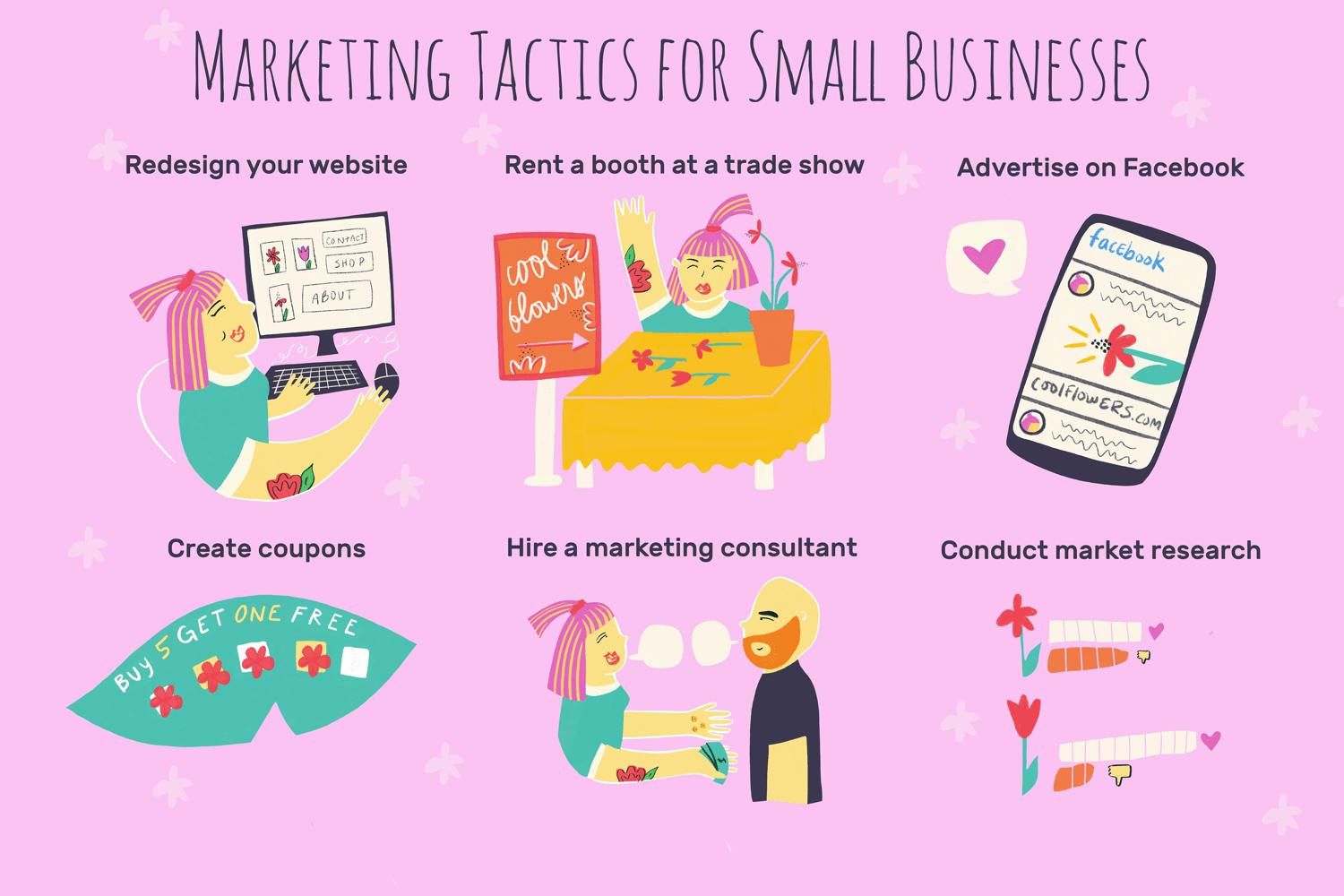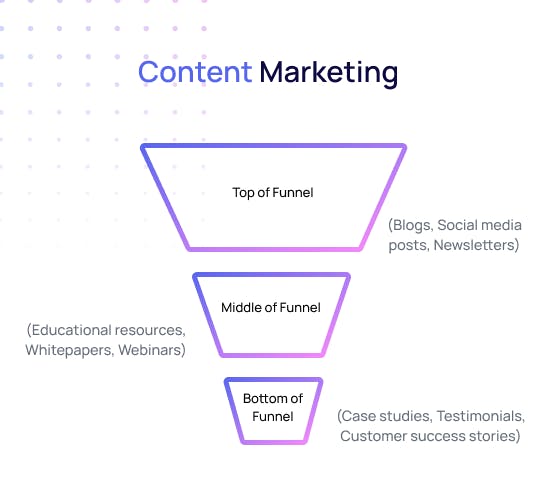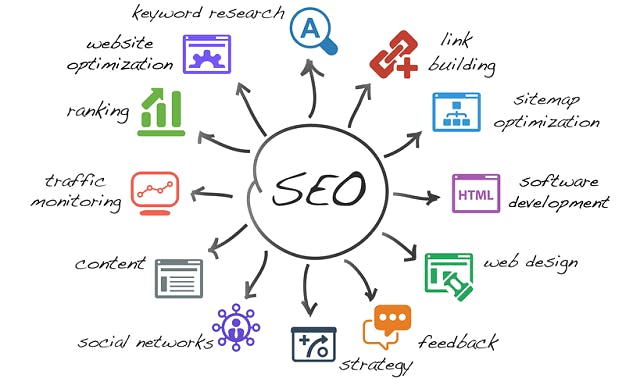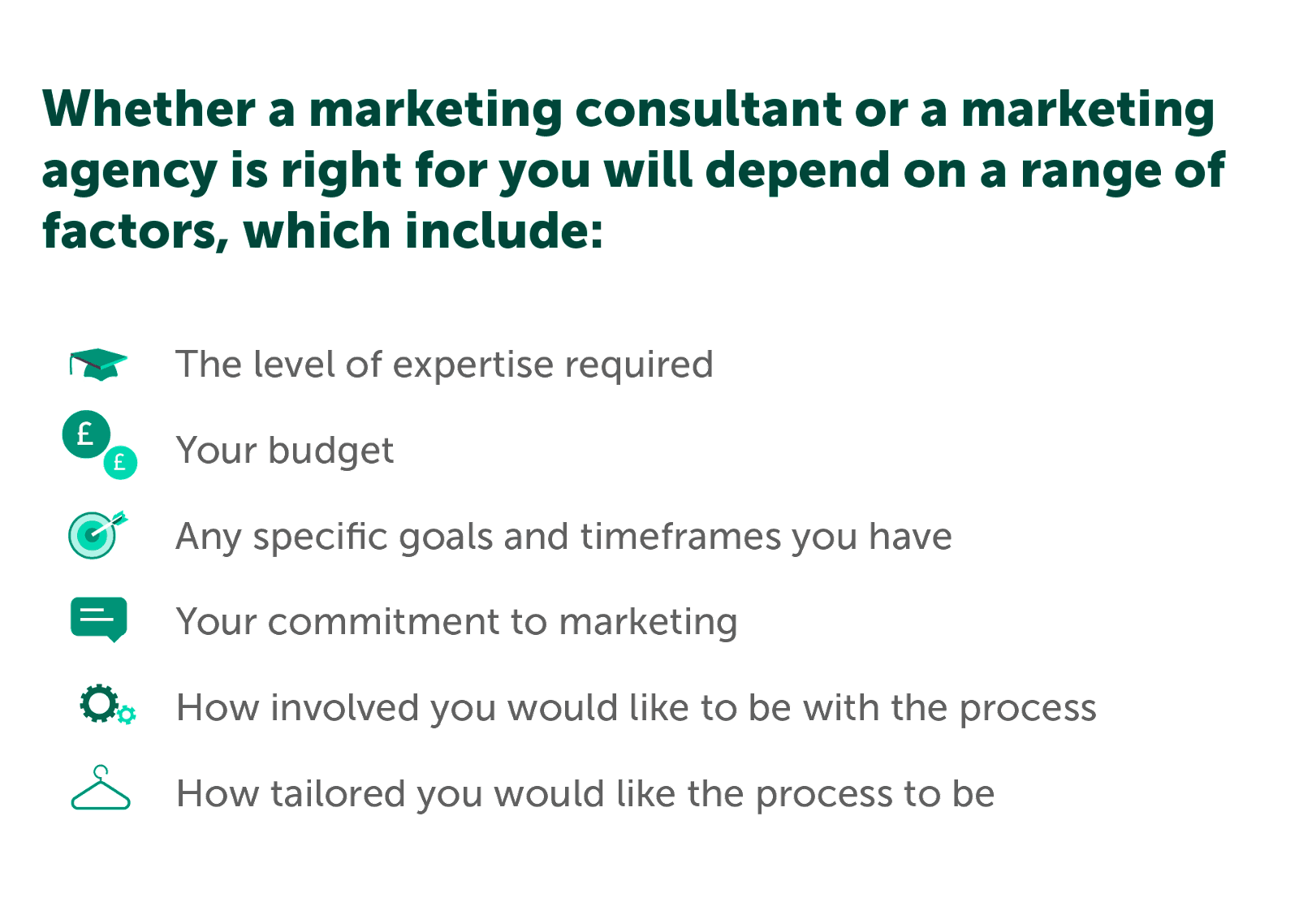Complete guide to small business marketing: ideas and strategies
Aug 10th, 2023

Contents
What is small business marketing?
Preparing to market your business
Ideas and strategies for small business marketing
In-house team vs consultant vs agency
The goal of any business, no matter big or small, is to attract and retain customers. Companies can achieve this objective and get exposure for their products and services through marketing. It encompasses market research, branding, positioning, advertising, and other activities aimed at reaching your target audience and communicating the advantages of your offering.
It may be challenging for small businesses to deal with the variety of marketing options available. As a result, a company with a great offering but poor marketing may fail, whereas a competitor with a mediocre product may succeed thanks to outstanding marketing efforts. However, small businesses often lack the funding and other resources required to implement a full-scale marketing strategy. In this guide, we will provide ideas on how to market your small business without going over the budget.
What is small business marketing?
Small business marketing is promoting your products and services to new and existing clients through different channels. It includes a set of strategies intended to raise awareness of the company while increasing sales and revenue by attracting new customers. The process involves identifying your target market, determining customer needs, goals, and problems, and positioning the product as the best solution.
Identifying the target audience for small businesses often requires the following steps: analyzing the potential consumer base, market research, and creating customer personas. The target market may be substantially narrower for small businesses because of their limited reach, particularly if the product targets a specific niche market. Therefore, this allows small companies to personalize interactions and develop long-lasting relationships with customers.
Marketing enables consumers to learn about the small business, understand the problem that they have, and the solution a company provides to address it without feeling pushed but instead relieved. It also helps create engagement, awareness, persuasion, and demand. These are all necessary for a brand that wants to expand its consumer base and maximize return on investment.
Preparing to market your business
Small business marketing is difficult when you're just starting or operating on a limited budget. Take into account the following advice to prepare for comprehensive marketing.
Step 1. Identify your audience
The first step towards creating a successful business is to find your niche. It would be a critical mistake to consider anyone as your buyer. While larger companies can target a wider audience, smaller businesses should determine who are their clients and what are their pains, challenges, and needs. By understanding what factors influence your customers’ purchasing decisions, you can create messaging that resonates with the audience and drives them to buy.
Group or segment your potential customers according to geography, demographics, behavior, lifestyle, and values to focus your marketing efforts. Then you can create a buyer persona or a fictional representation of your ideal customers based on information about them.
Step 2. Develop your value proposition
Your value proposition should differentiate your business from competitors in the industry and persuade prospects that the product is worth buying. It is often a short, one-sentence summary of the benefits that your company provides for the customers. Value proposition focuses on clients’ problems and demonstrates how your offering can solve them.
To develop your value proposition, think about what you do better than competitors, identify your customers’ main problems, and define your product’s benefits. Then describe what makes these competitive advantages valuable and connect this value to the client’s problem. Finally, consider what makes your value proposition unique and differentiates you from the competition.

Step 3. Study your competitors
A thorough understanding of your competitors helps you identify the most effective marketing strategies and use them to your advantage. Moreover, by analyzing your competition, you can learn about their pricing, advertising methods, and strengths and, as a result, make more informed decisions.
Therefore, you need to examine how your rivals promote their products. Check whether they primarily stick to digital marketing tools or also employ traditional advertising methods. Consider whether your competitors use social media to run marketing campaigns. In addition, analyze what language they use to describe their offerings.
Step 4. Conduct customer interviews
Customer interviews are an excellent approach to learning about the problems your consumers have, the solutions they seek, and their needs. There are two types of customer interviews: planned discussions and ad hoc conversations. Planned interviews involve asking clients a range of questions about their general experience or individual interaction with the company.
Ad hoc interviews are typically shorter. These discussions are held either through video software, on the phone, or in person. Even though online surveys are more convenient, ad hoc interviews provide you the chance to speak with the consumer at the moment and learn details about particular experiences and events.
Step 5. Set your goals and budget
The goal of your marketing campaign should be crystal clear before you launch it. Review what you want to accomplish with your marketing efforts. Do you want to grow revenue, attract new clients, or generate brand awareness in the first place? Your marketing objectives will allow you to understand which strategies and approaches are most suitable for your company.
In addition, you need to set your marketing budget. You can include the following elements: website development and maintenance, branding strategy, printing of marketing materials, advertising, search engine optimization strategy, hiring people to carry out marketing tasks, and buying software.
Now that you have a budget and a clear goal, it's time to organize and launch your campaigns. Further, we will discuss useful tips and methods that help you succeed in small business marketing.
Ideas and strategies for small business marketing
Let us consider the strategies that will help generate awareness and increase revenue for your company.
Use content marketing to increase organic traffic
With this method, you may engage potential clients and build organic website traffic by providing a variety of content formats, including text, video, and audio. Examples of content marketing include blog articles, news, educational videos, podcasts, infographics, and more. Although it requires a lot of work initially, if you invest in producing quality content, you will receive outstanding results in the longer run.

You may gain a following on YouTube by creating explainers, case studies, customer testimonials, and other types of videos about your brand that appeal to your target market. Moreover, you can produce short-form videos for Instagram, TikTok, and Facebook. This type of content is easily shared, allowing you to reach the proper audience with your marketing message.
Blog posts that provide answers to people’s queries on Google will help you increase organic traffic to your website. Additionally, a blog establishes your company as a thought leader in the industry and builds credibility. Even if you publish a blog post once a week, you will be able to improve your online visibility and educate potential customers about your product’s advantages. Remember to include a call-to-action in your posts so that readers may subscribe to your website and receive emails.
Promote your business on social media
Social media marketing is a resource that is available even if you have a small or no budget. Moreover, social media enables you to create a community around your brand and product. Since it is free, you can use this channel to publish user-generated content, gather feedback and address consumer problems. In addition, customers often check the company’s social media pages to read reviews and confirm that the business is worth trusting.
A significant number of available channels overwhelms many small business owners. The best strategy would be to choose one or two platforms with the most active audience and focus on them. Share educational and valuable content related to your industry rather than just articles that promote your products and encourage purchases.
Partner with influencers and other brands
Think about collaborating with well-known influencers in your industry. Influencers and bloggers can recommend your business to potential clients and significantly increase your reach. Since influencers are familiar with your niche market and have a talent for storytelling, they can communicate your brand’s message to the right audience.
Collaborating with a business serving a similar target market can help you expand your reach and marketing capabilities. You can start by offering complementary products and services. A complementary product is a bonus to the main item that a buyer purchases. For example, if your company sells protective cases for smartphones, you can partner with a smartphone manufacturer and offer a product bundle. You can also share email lists, write for one another's blogs, and create co-brand programs, advertisements, or sponsorships.
Invest in SEO
Investing in search engine optimization is one of the main strategies to attract visitors to your website. You may introduce your business to prospects with high purchase intent and position a company as a reliable authority using targeted SEO. The better your Google ranking, the more visitors you may drive to your website and the more sales you can expect.
To optimize your website for search engines, you should conduct keyword research and determine the most popular search terms. In addition, you need to ascertain that your website is user-friendly and easy to navigate. Along with it, you should generate quality content that resonates with your audience.

Furthermore, you can create Google My Business account. This strategy will allow your company to show up in the top results when consumers in the same location as yours search for a product on Google. When customers see your business profile with positive reviews, they are more likely to choose your company over the competitors.
Promote your business through PPC advertising
While organic traffic requires more time and resources to generate, you can achieve faster results with pay-per-click advertising. This form of advertising implies that you get charged a fee each time a user clicks on your advertisement. The probability that a term will rank at the top of the SERP increases if you choose popular keywords. However, it also implies that you will pay more when someone clicks on your advertisement.
PPC ads can be a powerful method to increase traffic to your website, especially if you target a certain keyword. You can run PPC advertising on Facebook, Instagram, Google, and other platforms. If you know that your target market is looking for your product or service online, Google Ads would be a perfect choice. Even though Google Ads are more expensive than other marketing methods we already listed, by combining pay-per-click advertising with content marketing strategy, you can achieve outstanding results and increase your reach.
Create an email marketing list
Email marketing is an affordable method of connecting with customers who have previously expressed interest in your business. You can start creating your email list by including a sign-up form on your website or blog. With email marketing, you can advertise upcoming events, provide subscriber-only discounts and build a community around your brand.
Many email service providers make launching an email marketing campaign easy and affordable. ESPs allow you to build email lists, utilize templates to create emails, and send them automatically. When someone signs up for your email list after making a purchase or joining to receive your content, you may contact them again to advertise new products.
Once you have chosen a suitable email marketing platform and built your email list, you need to segment this group taking into account customers’ characteristics, such as demographics, location, and purchase preferences. Then you can start sending emails to different consumer groups and provide them with useful content at the appropriate point in their customer journey to influence their purchasing decision.
Encourage customers to share their experiences
You can encourage customers to recommend your business to their friends and family by offering rewards, such as discounts or free products. With a referral program, you may increase your client base without spending much time and money advertising to new people. Instead, you're focusing on your current consumers, who have a good relationship with your business. These devoted clients will advertise your company on your behalf at little or no expense.
To create an effective referral program, you must ensure your customers understand what they should do and what they would get in return. Provide double-sided incentives that are designed both for referrer and friend. Offer products or services for free or at a significant discount, but only after a consumer has successfully referred numerous people to you.
Make sharing your referral program on social media as easy as possible for customers. Add buttons that allow users to customize and share pre-written message templates with only the click of a button. When communicating about your referral program, emphasize the importance of community. Use an upbeat tone that highlights supporting friends and your business. For example, "Share the love."
Remain consistent in your branding and messaging
If you don't have sufficient funds to engage a professional brand consultant, you may use internal resources to do the brand building and maintain brand consistency. It includes a logo, color palette, fonts, slogan, tone of voice, values, and a fixed description of your products. You aim to create a uniform message and an identical look across all your marketing and distribution platforms. You will look more professional and increase your ability to draw in new clients if you use a consistent brand identity to advertise your business.
Spend some time considering how you want people to perceive your brand. Create brand guidelines to ensure consistency in your terminology and visuals. If you start with a warm conversational tone, your audience can find it surprising if you suddenly turn to something more formal and instructional. In other words, your brand is what people think and feel when they hear the name of your business.
Feel free to try something new if you're curious about a social network or a recent marketing trend. Have a strong hypothesis or question in mind before you consider a new marketing strategy. It will help you avoid distractions and concentrate on the eventual result.
In-house team vs consultant vs agency
Now we will discuss the difference between implementing the marketing strategy with the help of an in-house team, a marketing consultant, and a marketing agency. Let us look at the pros and cons of each approach.
In-house team
The in-house marketing team is a department dedicated to managing all company’s marketing-related tasks. Employees do all marketing for the company's products or services. The size of the in-house marketing teams varies depending on the size of the company. This department often covers communications, advertising, web development, and social media.
Pros. Companies may participate in every aspect of marketing thanks to the transparency provided by the structure of the marketing team. When working with an internal marketing team, businesses have total control over their data and expenses.
What is more, in-house marketing teams have a good understanding of the products and services, so they can develop consistent messaging and branding. Since the team is based in one location and works together, a marketing department within the organization can communicate with business owners, stakeholders, and staff members faster.
Cons. In-house marketing teams often lack expertise and resources compared to marketing agencies. Even if they have a lot of marketing knowledge, it's typically focused on one or two areas. When working with an internal team, the same personnel are involved in the same marketing initiatives. As a result, the marketing staff may lose inspiration and be less likely to come up with creative ideas.
Finding the ideal people for an internal marketing department is challenging. You have to dedicate enough time to recruiting, employing, and training new personnel. Moreover, if you don't engage external professionals to support you along the process, finding the right employees may cost you a lot of time and resources.
Marketing consultant
A marketing consultant can help you create a strategy, find problems in your advertising campaigns and provide recommendations. A consultant offers services for a limited period, unlike an in-house team or an agency.
Pros. Before transitioning to consultancy, a marketing professional often has years of experience working in corporations. Furthermore, they have experience dealing with customers. A consultant can look at your business from a new perspective, in contrast to in-house marketers who often get caught up in the corporate culture and may be having a hard time thinking outside the box.
Hiring a consultant is often a more cost-effective option than employing an internal team. Since a consultant usually works under a contract, the pay will depend on the number of hours. In addition, a consultant's expertise helps you in other aspects of marketing, including sales, content marketing, and advertising. Therefore, one consultant can replace several employees.
Cons. While they are working with you, a consultant may also be working with four or five other clients. They might not always be available on demand as a result. Moreover, a consultant adds a fresh perspective to the company, so the CMO can find the advice intrusive. Conflicts may also arise while implementing particular plans and campaigns.

Marketing agency
In this scenario, you contract with an outside marketing firm to handle your marketing. It is an excellent option for small businesses needing help focusing on marketing when there are so many other things to accomplish.
Pros. Web developers, digital marketers, social media managers, SEO specialists, graphic designers, content writers, and even product marketing managers are all part of a marketing agency's staff. These employees allow agencies to address any customers’ problems effectively. Furthermore, a marketing agency has access to specialized software and tools, which are often too expensive for a small company.
Cons. When you delegate your marketing tasks to the agency, you have less operational control over the process. Although the agency will do the majority of the work, you shouldn’t choose this option if you believe having little control is risky.
Smaller, lesser-known firms sometimes deal with several clients at once, so your projects can be delivered after their due date. Thus, when looking for an agency to handle your marketing, choose one that is reputable, trustworthy, and one that will be able to complete the work on time.
Marketing is an experimental process. Choose the strategy and then test it. To determine whether your plan is successful, evaluate the outcomes using marketing metrics like ROI. If not, try a fresh approach. Keep trying new strategies to market your small business until you find one that works.
